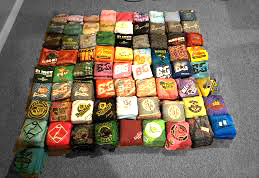As with any competitive endeavor, cornhole players develop and tune their own technique. We’ll talk about the one technique that’s common across every competitive bagger, then talk about the areas in which you’ll need to figure out what works best for you. A good place to start is by watching this ESPN “Sports Science” breakdown of the game, featuring California state champ Nick Renevitz:
https://www.youtube.com/embed/tEkEQTfXTwU
Job 1: Throw a Flat, Spinning Bag
While many backyard players wad the bag up in their hand and throw it willy-nilly so it tumbles through the air, virtually all experienced cornhole players hold the bag flat in their hand and give it a little spin so it flies through the air “flat.” Like rifling on a bullet, that spin improves the aerodynamics of the bag for more consistent flight. Second, landing the bag flat on the board reduces the unpredictability associated with coming in all crazy. And maybe most importantly, a flat spin means the bag will always land on whatever side was facing down when you released it. That’s critical because good cornhole bags are sticky on one side and slick on the other. More on that in a bit.
Put Your Best Foot Forward
Generally speaking, cornhole players throw bags with their feet staggered — one foot at the front edge of the board, the other behind them. Most right-handed players throw with their left foot forward, and lefties with their right foot forward. That said, but plenty of people throw “goofy footed” with their dominant side’s foot forward. Experiment and see what works for you!
To Step, or Not to Step?…That is the Question!
Some players stand fixed in their throwing position, with their weight over their front foot. Others start with their weight on their backfoot and shift forward as they throw. The other common technique is to stand with both feet together toward the back of the board, and step forward as part of the throw, almost like an abbreviated bowling approach. Try ’em all and figure out what works for you!
Stick and Slick Strategy
Quality cornhole bags are sticky on one side and slick on the other. Combined with the ability to throw a bag that flies “flat,” that lets you throw a bag that slides along the board, or that stops near where it lands. You’ll want to throw your cornhole bag with the slick side down when you’re trying to slide the bag the length of the board, or to push a bag that’s already on the board into the hole. You’ll want to throw the bag sticky side down as a “blocker” to deny your opponent a clean line at the hole.
Choosing the right cornhole bag

Choosing the right double sided cornhole bag is harder than you think. It’s not as easy as just using the same bag your friend throws or one that the Pros use. You need to find a bag that performs to your throwing style.
As you may already know, there are tons of cornhole bag options out there. Many different manufacturers and each one has multiple designs and styles. And when you read the descriptions, they all say “this is the bag for you”. But is it really the one bag for you? How can they all be perfect for everyone? They can’t, so let’s try to find one that is best for you.
Anatomy of a cornhole bag
Let’s talk about the anatomy of a cornhole bag first. It’s size, weight, thickness, shape, rounded or square corners, what’s inside, etc. So much work goes into creating each bag and although many of them look the same, they are far from it. The American Cornhole League(ACL) regulates cornhole bags that they must be 6”x6” and weight in the range of 15.5 – 16 oz. The ACL also doesn’t allow any fill besides plastic resin pellets.
With so many bags on the market today, can they really be different? Of course they can since they can all vary from the different fabrics, filling, rounded to square corners and seams. The most affordable double sided bags normally are a premium duck cloth on one side and suede on the other. This provides the player with the option of throwing the “slick” (duck cloth) or “stick” (suede) side down.
But it doesn’t stop there. Slide materials vary as much as your choice for a new sedan. Synthetic materials provide a more weather resistant bag to a certain point. The choices right now are unlimited, whereas 3 years ago it was corn or resin filled and “stick side” or no “stick side”.
All ACL approved bag manufacturers use the resin pellets because they are a great all-weather fill and don’t leave a residue on the boards. Resin also comes in different sizes and textures to further add to the feel of the bag. The resin pellets will not breakdown over time and will give the user a consistent throwing experience every time you use the bags.
And the best part of resin? You can wash the bags when you play in that rain or shine event. Or that one time your brother in law missed the board by 10 feet and put it in the pool. With corn filled bags however, get them wet and they are done. Don’t forget those little rodents love corn.
With the corners and seams of the bags, we really don’t have a preference as to which is better and why but most advanced players prefer rounded corners with no seam on the outside. Some advanced players prefer a bag with no stick side as well.